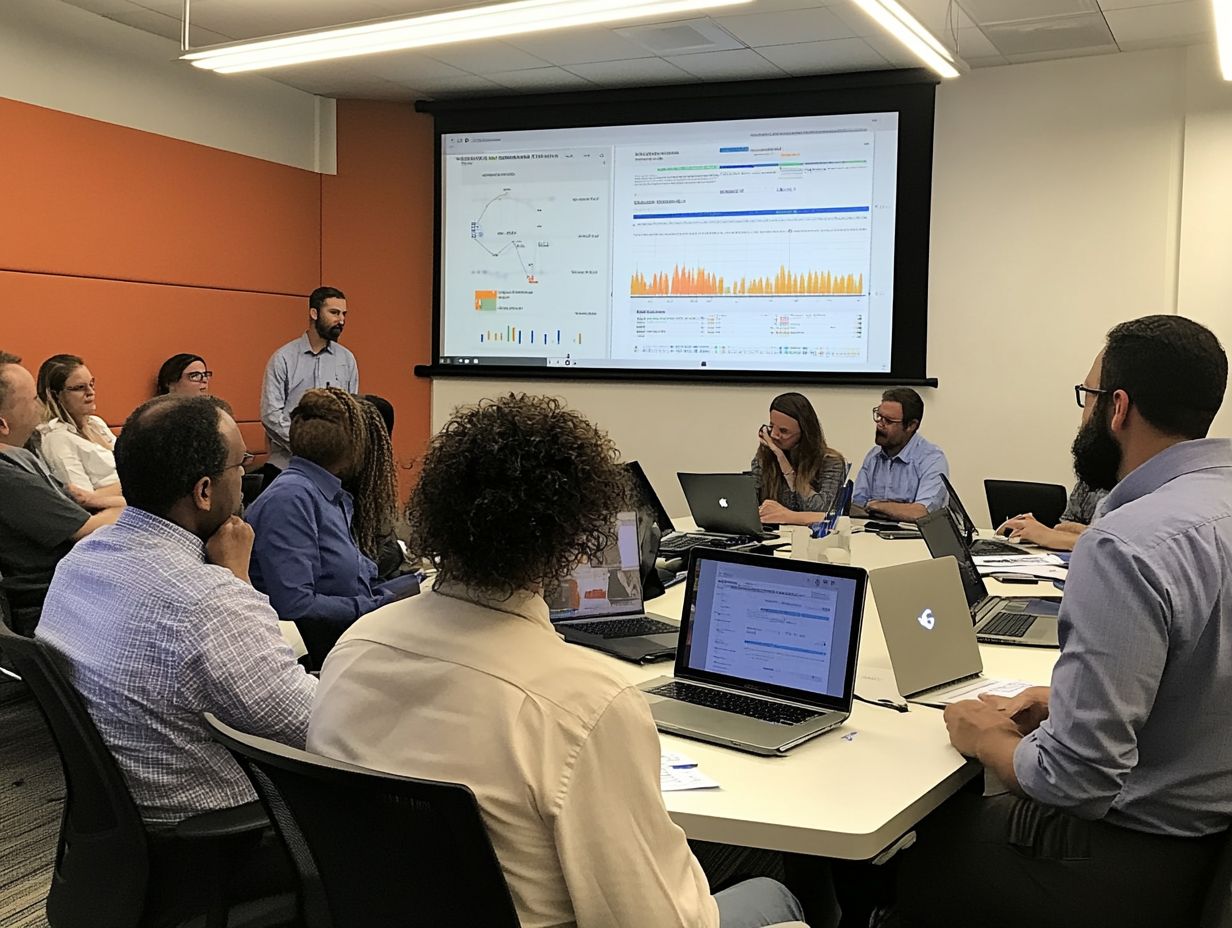vulnerability assessment training: what you need to know
In today s digital landscape, grasping the nuances of vulnerability assessments is essential for safeguarding your organization s security. This article delves into what vulnerability assessments entail and highlights their critical role in your defense strategy.
You ll discover the various types of assessments, the key components that make them effective, and the benefits of training in this domain. Whether your goal is to enhance security measures or mitigate potential risks, this guide equips you with the insights and best practices necessary to conduct thorough and effective vulnerability assessments.
Contents
- Key Takeaways:
- Understanding Vulnerability Assessments
- Types of Vulnerability Assessments
- Key Components of a Vulnerability Assessment
- Benefits of Vulnerability Assessment Training
- How to Conduct Vulnerability Assessment Training
- Frequently Asked Questions
- Curious about vulnerability assessment training?
- What is vulnerability assessment training?
- Why is vulnerability assessment training important?
- Who should attend vulnerability assessment training?
- Who Should Attend Vulnerability Assessment Training?
- What Will You Learn?
- Is This Training Only for Tech Pros?
- How Often Should You Train?
Key Takeaways:

Security checks are crucial for identifying and mitigating potential threats to your organization’s assets. There are different types of security checks, including internal vs. external and network vs. application assessments. Proper training in these assessments can improve security measures, reduce risks, and minimize potential damages to your organization.
Ready to start your own vulnerability assessment? Let’s go!
Understanding Vulnerability Assessments
Understanding vulnerability assessments is essential for enhancing your cybersecurity program. This process involves systematically identifying, classifying, and prioritizing security vulnerabilities present in your information systems.
These assessments are not merely a compliance requirement; they are the foundational step in threat analysis. They lay the groundwork for effective risk identification and management strategies.
What is a Vulnerability Assessment?
A vulnerability assessment is a systematic process that helps you identify and analyze security weaknesses within your organization’s information security framework. By using different ways to check for vulnerabilities, you can ensure comprehensive coverage.
This essential exercise serves multiple purposes. It primarily aims to mitigate risks associated with potential threats, such as malware attacks and unauthorized access.
Using tools like network scanning and application assessment allows you to pinpoint weaknesses that might otherwise go unnoticed. This assessment is key to your security strategy, enabling you to take proactive measures to safeguard sensitive data.
Conducting regular vulnerability assessments strengthens your security posture and cultivates a culture of continuous improvement in protecting your digital assets against ever-evolving risks.
Why are They Important?
Vulnerability assessments are vital because they provide a clear understanding of your potential risks and assist in crafting a step-by-step plan to fix identified security threats.
By systematically pinpointing weaknesses within your systems, these assessments help you prioritize your cybersecurity initiatives effectively. Regular evaluations reveal existing security gaps and guide you in implementing crucial measures to mitigate potential attacks.
In today’s fast-changing digital world, integrating these assessments into your security protocols is more important than ever. Enhanced risk analysis from these evaluations equips your team with insights needed to allocate resources wisely and strengthen your overall cybersecurity practices, ultimately fostering a more resilient infrastructure.
Types of Vulnerability Assessments
You have a range of vulnerability assessments at your disposal, each designed to target specific elements of your security posture.
These assessments can encompass:
- Network vulnerabilities
- Application vulnerabilities
- Host-based scans
- Wireless vulnerability scans
This variety allows you to fortify your defenses comprehensively.
Internal vs. External Assessments
Internal assessments focus on identifying vulnerabilities within your organization s security system, while external assessments aim to uncover threats that could be exploited from outside. Both types are vital for strong security checks.
The goal of internal assessments is to take proactive measures, ensuring that any weaknesses within your systems and processes are swiftly addressed. External assessments simulate real-world attacks to evaluate how well your organization can fend off potential threats from malicious actors.
You ll employ different methodologies, such as penetration testing, which simulates attacks to find weaknesses, and vulnerability scanning, which checks for known flaws, to gather actionable insights.
By maintaining a balanced approach and integrating findings from both assessments, you bolster your defenses and ensure regulatory compliance. This commitment ultimately safeguards sensitive data and reinforces trust among your stakeholders.
Network vs. Application Assessments
Network assessments are essential for pinpointing security vulnerabilities within your network infrastructure, while application assessments examine the security posture of your software applications.
Each uses specific methods to find risks. Network assessments focus on your hardware, firewalls, and protocols that govern data transmission, whereas application assessments dive into the software realm, scrutinizing code, user interfaces, and integrations.
Utilizing techniques such as penetration testing and automated scanning tools, both types systematically reveal vulnerabilities that malicious actors could exploit. While their approaches may differ, they share a common objective: strengthen defenses and reduce the risks associated with unauthorized access or data breaches.
It s critical for organizations to integrate both assessments quickly into their security strategies.
Key Components of a Vulnerability Assessment

The essential elements of a vulnerability assessment involve recognizing your assets and potential threats, performing thorough vulnerability scans, analyzing the results of those scans, and implementing effective remediation strategies. This smart strategy keeps your systems safe from threats.
Identifying Assets and Threats
Identifying your assets and threats is a crucial step in the vulnerability assessment process. This establishes a baseline for what requires protection and what potential risks lurk within your network infrastructure.
This phase involves systematically cataloging all your digital and physical assets, ranging from servers to sensitive data repositories, while mapping out their interconnections and dependencies.
Conducting a thorough threat analysis helps uncover various system vulnerabilities that malicious actors may exploit, whether through insider threats or external cyberattacks.
Recognizing both the obvious and subtle threats allows you to prioritize your security efforts, ensuring every layer of your network infrastructure is fortified against potential breaches.
Conducting Vulnerability Scans
Conducting vulnerability scans requires employing specialized tools designed to uncover security weaknesses, based on carefully crafted scan configurations and policies tailored to your organization s unique environment.
This process starts with selecting the right scanning tools, which can range from open-source options to premium commercial products, depending on your needs and budget. Once you’ve made your selection, configuring these scans is essential.
You ll need to define the scope, choose the types of vulnerabilities to search for, and establish an appropriate frequency for conducting the scans.
By adhering to established scan policies, you ensure compliance and maintain consistency in detecting vulnerabilities. These policies set clear parameters around scanning schedules, target systems, and reporting protocols.
Regular updates to your scan configurations are crucial, as they help you adapt to evolving threats and technological changes, ensuring your security posture remains robust and effective.
Benefits of Vulnerability Assessment Training
Vulnerability assessment training provides you with a wealth of advantages, primarily by strengthening the security measures within your organization.
It creates a proactive approach to cybersecurity awareness among your staff, which is critical for crafting a robust mitigation plan against potential threats.
Embracing this training not only fortifies your defenses but also enables your team to take an active role in safeguarding your digital environment.
Improving Security Measures
Improving security measures is a key outcome of effective vulnerability assessment training. It equips you and your team with the essential knowledge and skills to manage and mitigate security vulnerabilities proficiently.
This training helps you spot potential risks and weaknesses within your systems, ensuring that security protocols are not only established but also continuously reviewed.
Regular assessments and audits are crucial for adapting to evolving threats. Outdated defenses can leave your organization vulnerable.
By engaging in continuous vulnerability assessments, you’ll be able to proactively recognize new vulnerabilities and implement timely solutions. This means you can react faster and stay safer against cyber threats!
This adaptive approach fosters a culture of security awareness, enabling your organization to respond swiftly to incidents, ultimately strengthening your resilience against cyber threats.
Reducing Risks and Potential Damages
By focusing on risk reduction and potential damages, vulnerability assessment training enables you to identify and address vulnerabilities before they can be exploited by malicious actors. This proactive approach enhances your overall security posture and plays a crucial role in effective risk analysis.
The training equips you with the skills needed to recognize and mitigate risks in real time. Insights gained from this training help your organization build resilience against future attacks, ensuring a swift adaptation to changing threat landscapes.
Implementing such training cultivates a culture of vigilance and accountability, where everyone plays a vital role in safeguarding critical assets and minimizing exposure to vulnerabilities.
How to Conduct Vulnerability Assessment Training
Conducting vulnerability assessment training effectively demands a structured approach that seamlessly integrates best practices and strategic insights.
This ensures that you, as a participant, gain a thorough and nuanced understanding of vulnerability management.
Best Practices and Tips

Implementing best practices and tips in vulnerability assessment training significantly enhances its overall effectiveness. It ensures that you can apply your knowledge in real-world scenarios to bolster security measures.
By concentrating on practical exercises, interactive discussions, and simulated environments, you ll find it easier to grasp complex security concepts. Integrating real-life case studies will clarify the implications of vulnerability management.
Continuous feedback through assessments encourages open dialogue among participants, fostering a collaborative learning atmosphere that benefits everyone involved.
Tailoring the training to address your organization s specific concerns can lead to higher engagement and better retention of information.
Adopting these strategies highlights the importance of thorough vulnerability assessments and enables your team to proactively tackle emerging threats.
Frequently Asked Questions
Curious about vulnerability assessment training?
What is vulnerability assessment training?
Vulnerability assessment training is a process of educating individuals or organizations on how to identify, analyze, and manage potential vulnerabilities (weaknesses that can be exploited) in their systems, networks, or processes. It helps in understanding the risks and threats that could compromise the security of sensitive information.
Why is vulnerability assessment training important?
Vulnerability assessment training is important as it helps in identifying and addressing potential security vulnerabilities before they are exploited by malicious actors. It also improves the overall security posture of an organization and ensures compliance with regulations and standards.
Who should attend vulnerability assessment training?
All personnel involved in cybersecurity efforts, including IT staff, security teams, and management, can benefit from attending vulnerability assessment training.
Who Should Attend Vulnerability Assessment Training?
This training is essential for IT professionals, security analysts, managers, and compliance officers. It is also great for anyone eager to enhance their skills in spotting and addressing weaknesses in systems.
What Will You Learn?
In this training, you’ll discover various types of vulnerabilities and the tools used to identify them. You ll also gain hands-on experience in performing assessments and developing strategies to mitigate risks.
Is This Training Only for Tech Pros?
No! Vulnerability assessment training is valuable for both technical and non-technical staff. Everyone will learn about security risks and effective management techniques.
How Often Should You Train?
Conduct vulnerability assessment training at least once a year to stay updated on security threats. Depending on your organization’s needs, consider increasing the frequency.







